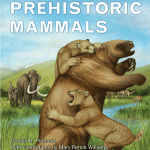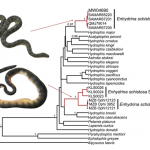Morphology and Diet
The Princeton Field Guide to Prehistoric Mammals ,by Donald R. Prothero, is the first extinct animal book that you, dear reader, are going to give to someone for the holidays.
This book is an interesting idea. Never mind the field guide part for a moment. This isn't really set up like a field guide, though it is produced by the excellent producers of excellent field guides at Princeton. But think about the core idea here. Take every group of mammal, typically at the level of Order (Mammal is class, there are more than two dozen living orders with about 5,000 species) and ask for each one, "…
Sea snakes are true snakes that look a little like eels because of their horizontally flattened rudder-like tails, and they spend a lot of time...for most species, their entire lives...in the ocean. Only one species seems to be able to move on land at all. They seem to all be venomous, some extremely so. They are all tropical or near-tropical, and there are numerous species distributed among about 15 genera.
One species is Enhyrina schistosa, known as the Beaked Sea Snake, or the Hook-Nosed Sea Snake. It lives in the waters near Indonesia and Australia. This is known to be the most…
... and made a real mess of the place when one of them spotted the jar of pickles on the counter. They fought over it until one of them had almost all the pickles and the other one had a number of bruises and a tiny fragment of one pickle that the other chimp dropped by accident.
That would be the way it would happen if two chimps walked into a bar. Or imagine two chimps, and each finds a nice juicy bit of fruit out in the forest. And instead of eating the fruit, because they are not hungry, they carry it around for a while (this would never happen, but pretend) and then accidentally run…
There is a new paper, just coming out in Proceedings of the National Academy of Sciences, that explores the idea that humans have undergone an increased rate of evolution over the last several tens of thousands of years.
By an increased rate of evolution, the authors mean an increased rate of adaptive change in the genome. By recent times, the authors mean various things, depending on which part of the analysis you examine, and depending on what is meant by "increased." ... In other words, the timing of an event that is not really an event (but rather a change in rate of something) is hard…
Stephen Jay Gould and David Pilbeam wrote a paper in 1974 that was shown ten years later to be so totally wrong in its conclusions that it has fallen into an obscurity not usually linked to either Gould or Pilbeam. However, they were actually right in ways that they could not have anticipated. And even if they were not right, this paper still has much to contribute, including the opening words of that publication in Science, which are very much worthy of consideration for many reasons:
It is no longer true that there are more practitioners than pieces. In fact, when I encountered this…
There is a new paper out suggesting that the Flores hominids, known as Hobbits, were "human endemic cretins."
From the abstract of this paper:
... We hypothesize that these individuals are myxoedematous endemic (ME) cretins, part of an inland population of (mostly unaffected) Homo sapiens. ME cretins are born without a functioning thyroid; their congenital hypothyroidism leads to severe dwarfism and reduced brain size, but less severe mental retardation and motor disability than neurological endemic cretins. We show that the fossils display many signs of congenital hypothyroidism, including…
Fallback foods are the foods that an organism eats when it can't find the good stuff. It has been suggested that adaptive changes in fallback food strategies can leave a more distinct mark on the morphology of an organism, including in the fossil record, than changes in preferred food strategies. This assertion is based on work done by the Grants and others with Galapagos Island finches, by Richard Wrangham and me with hominids, and by Betsy Burr and me with rodents.
The reason for this is simple. There is a rough correspondence between how much energy one can obtain from a food type and…
Comparing living chimpanzees to living humans, in reference to the species that gave rise to these two closely related species, is one way to frame questions about the evolution of each species.
Generally, it is useful to address evolutionary questions by comparing two living species with the reconstructed "last common ancestor" (LCA) of those species. All of the similarities and differences between the LCA and the living form, in each lineage, represent evolutionary "stories" (that could even be worked out as hypotheses). Similarities indicate important, long-maintained adaptations, and…
Homo floresiensis more widely known as the "Hobbit," may have had arms that were very different from those of modern humans.
A paper in the current issue of the Journal of Human Evolution explores the anatomy of H. floresiensis. To explore this we first have to understand the concept of "Humeral torsion." Humeral torsion is the orientation of the humeral head relative to the mediolateral axis of the distal articular surface. Don't bother reading that sentence again, I'll explain it.
The humerus is the upper arm bone, that runs between your shoulder and your elbow. The humeral head is…
Every few years a paper comes out "explaining" short stature in one or more Pygmy groups. Most of the time the new work ads new information and new ideas but fails to be convincing. This is the case with the recent PNAS paper by Migliano et al.
From the abstract:
Every few years a paper comes out "explaining" short stature in one or more Pygmy groups. Most of the time the new work ads new information and new ideas but fails to be convincing. This is the case with the recent PNAS paper by Migliano et al.
From the abstract:
Explanations for the evolution of human pygmies continue to be a…
There seems to be some interesting things going on with the recently reported study of rates of evolution in humans. We are getting reports of a wide range of rather startling conclusions being touted by the researchers who wrote this paper. These conclusions typically come from press releases, and then are regurgitated by press outlets, then read and reported by bloggers, and so on. Here is, in toto, the press release from the University of Wisconsin, where John Hawks, one of the authors of the study, works. I reproduce the press release here without further comment.
Genome study…
There is a new paper, just coming out in Proceedings of the National Academy of Sciences, that explores the idea that humans have undergone an increased rate of evolution over the last several tens of thousands of years.
By an increased rate of evolution, the authors mean an increased rate of adaptive change in the genome. By recent times, the authors mean various things, depending on which part of the analysis you examine, and depending on what is meant by "increased." ... In other words, the timing of an event that is not really an event (but rather a change in rate of something) is hard…
Birds evolved during the Mesozoic, during the various "Ages" of the dinosaurs, as a subset of those dinosaurs. Many researchers believe that these early birds were different from their then very close dinosaur cousins because of their flight adaptations, and some have linked this idea to flight-based or tree- based foraging.
Today, most birds fly (counting by species) and their flight is linked to their primary dietary adaptation. Some birds actually feed on the wing, while others fly to food sites and once there do not locomote very much. Other birds forage on the ground habitually. The…

